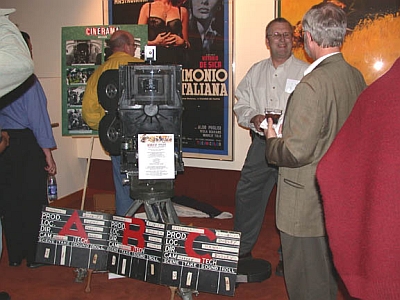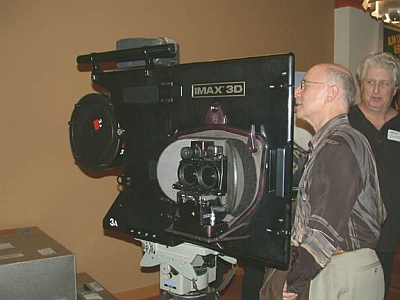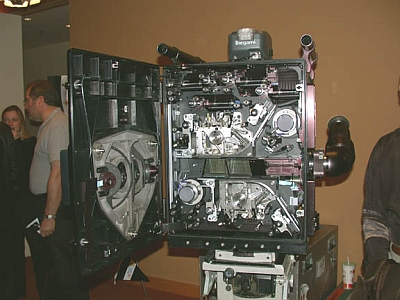An Historical Overview Of Wide Screen Motion Pictures |
Read more
at in70mm.com The 70mm Newsletter |
| Written by Rick Mitchell, Film Editor/ Film Director/ Film Historian. Photographed by: Richard Greenhalgh | Date: March 18, 2004 |
 The Hollywood Section of the Society of Motion Picture and Television Engineers has learned over the years that it's guaranteed a full house when a monthly meeting is devoted to Visual Effects, Film Preservation, or the Historical Evolution of Color, Sound, and/or Wide Screen. The last was the subject of its second meeting at the Linwood Dunn Theater in the Academy of Motion Picture Arts and Sciences new Mary Pickford Building on Mar. 16, 2004. This is where the Academy's vast archive of film prints and other memorabilia is stored, in vaults named after Pickford films! The Hollywood Section of the Society of Motion Picture and Television Engineers has learned over the years that it's guaranteed a full house when a monthly meeting is devoted to Visual Effects, Film Preservation, or the Historical Evolution of Color, Sound, and/or Wide Screen. The last was the subject of its second meeting at the Linwood Dunn Theater in the Academy of Motion Picture Arts and Sciences new Mary Pickford Building on Mar. 16, 2004. This is where the Academy's vast archive of film prints and other memorabilia is stored, in vaults named after Pickford films!Although there are certain films related to each subject that it is almost mandatory to mention, those behind each of the presentations I've seen over the last 30 years have also amazed the audience with fresh and often rarely seen material. Unfortunately this has grown more difficult in recent years as home video seems to have left American audiences unreceptive to less than perfect prints, severely limiting the examples of early color, 70mm, and 35mm 4 track magnetic sound considered showable. However, Richard May of Warner Bros., who put this program together, came through as usual. The program opened with a clip from "GONE WITH THE WIND", as an example of a type of film that would have been made in a Wide Screen process if one had been in vogue at the time. Mention was made of the fact that producer David O. Selznick had had the Burning of Atlanta sequence shot with a horizontal dual camera rig but decided the film was going to be big enough without the cost of equipping initial roadshow theaters for this special presentation (that the film's post-production was down to the wire may have been another reason for dropping it.) However, the late George Turner has noted that many of the theaters still equipped with the Magnascope lens used it to show this sequence as they had with big scenes from earlier films and would do with the hurricane sequence in Selznick's later "PORTRAIT OF JENNY" (1948), although here his publicist Russell Birdwell capitalized on the its by calling the presentation Cycloramic, with Cyclophonic Sound. Not mentioned was that the clip shown was from one of the controversial anamorphic IB prints made for the film's 60 anniversary re-release in 1998. |
Further
in 70mm reading: SMPTE Meeting #1 Internet link: |
 Next came a real treat, a clip from "THE BAT WHISPERS" (United Artists; 1931), shot on 65mm negative and restored to 35mm anamorphic by the UCLA Film Archives; in some ways a better choice than the originally sought
"THE BIG TRAIL" (1930), as " THE BAT WHISPERS"
has only been shown once in the L.A. area. Where " THE BIG TRAIL"
beautifully shows off the scenic areas in which it was shot, BAT, an adaptation of one of the "haunted house" thrillers that were popular on the stage in the Twenties, makes incredible use of the wide screen in the dark, high contrast style of German silents of the time. The sequence shown, from the first reel, setting up the activities of the titular master criminal, is another instance of giving the lie to the stasis of early sound films, with incredible wide screen compositions, use of shadows, and even quaint miniatures. The clip in question also included some of the shots duplicated from the concurrently shot 35mm version, apparently by rephotographing a 35mm print with the 65mm camera as no 35-65 optical printer existed. Next came a real treat, a clip from "THE BAT WHISPERS" (United Artists; 1931), shot on 65mm negative and restored to 35mm anamorphic by the UCLA Film Archives; in some ways a better choice than the originally sought
"THE BIG TRAIL" (1930), as " THE BAT WHISPERS"
has only been shown once in the L.A. area. Where " THE BIG TRAIL"
beautifully shows off the scenic areas in which it was shot, BAT, an adaptation of one of the "haunted house" thrillers that were popular on the stage in the Twenties, makes incredible use of the wide screen in the dark, high contrast style of German silents of the time. The sequence shown, from the first reel, setting up the activities of the titular master criminal, is another instance of giving the lie to the stasis of early sound films, with incredible wide screen compositions, use of shadows, and even quaint miniatures. The clip in question also included some of the shots duplicated from the concurrently shot 35mm version, apparently by rephotographing a 35mm print with the 65mm camera as no 35-65 optical printer existed. (" THE BAT WHISPERS" also has an interesting connection with Mary Pickford: executive producer Joseph M. Schenck had been hired by the founders of United Artists to bring in other filmmakers as the founders weren't turning out enough product to support the company's overhead. In 1933, Schenck quit to form 20th Century Pictures with Darryl F. Zanuck and the negatives of many of the films made under the banner of his Art Cinema company were turned over to their directors and subsequently lost. However, the 65mm negative of " THE BAT WHISPERS" somehow ended up with Mary Pickford's films, which she had had properly preserved by the standards of the time and, when discovered there by the UCLA preservationists, was reportedly in perfect shape. Cinerama, of course, started the Wide Screen Revolution in 1952 and was represented by the opening of "HOW THE WEST WAS WON" (MGM; 1962), using a 35mm anamorphic reduction print from an internegative onto which the three panels had been combined. (It's my understanding that this combining was actually done from the three panel negatives to a 65mm IP, possibly in the Ultra Panavision format, from which subsequent anamorphic 35mm and 16mm internegatives were made.) While not as impressive as seeing it in three panel, and though the Dunn's screen is flat, this presentation did give the audience an idea of Cinerama was like, even with mono optical sound. |
The American Cinematographer did an article on the "THE BAT WHISPERS" restoration in the Nineties which has some frame blowups |
 The next treat of the night was the opening of "THE ROBE" (20th Century-Fox; 1953), the first CinemaScope picture, using a new composite print which looked very much like the print shown at the Academy last November. I was told this print was from an internegative from an IP made from the usable material from the original negative filled out with material from separations. The print had a Dolby SR track, making it impossible to show it at 2.55:1, but sounded as good as the transfer from the 4 track dub master shown double system at the
Academy's Goldwyn Theater. The next treat of the night was the opening of "THE ROBE" (20th Century-Fox; 1953), the first CinemaScope picture, using a new composite print which looked very much like the print shown at the Academy last November. I was told this print was from an internegative from an IP made from the usable material from the original negative filled out with material from separations. The print had a Dolby SR track, making it impossible to show it at 2.55:1, but sounded as good as the transfer from the 4 track dub master shown double system at the
Academy's Goldwyn Theater.This was followed by a clip from "AROUND THE WORLD IN 80 DAYS" (United Artists/Warner Bros.; 1956) from a 35mm Technicolor IB print from the Academy archive. Naturally it was the sequence in which David Niven and Cantinflas rise in a balloon from the Universal backlot (I spotted the top of a soundstage in one POV shot) to soar over Paris and the French countryside, accompanied by Victor Young's great theme. Unlike "OKLAHOMA!", which was filmed in 65mm at 30 fps and 35mm CinemaScope for general release, both versions of " AROUND THE WORLD IN 80 DAYS" were filmed in 65mm, at 30 fps for the 70mm version and 24 fps for the 35mm version, so this print, though not as sharp as later IB prints, was an acceptable representation of early Todd-AO. For the record, Warner Bros., which now owns " AROUND THE WORLD IN 80 DAYS", has been working on the 30 fps version for DVD; unfortunately there is no talk of making a print as, supposedly, there are not enough places where it could be shown to recover the cost. Too bad it's not a favorite film of Paul Allen. Next came a clip from "KISMET" (MGM; 1955), which host David Browning implied, possibly erroneously, was one of the seven MGM films shot both in CinemaScope and spherically before the development of squeezing/unsqueezing optical printer lenses. "KISMET" and "THE ROBE" are brilliant examples of how far film restoration has come in just five years. Just that recently, it was feared that new prints from the original negatives of pre-1962 color films were doomed to have washed out colors with yellow highlights and blue shadows, or to be printed from inferior separations made by dry printing and not really checked, meaning they're likely to have new problems of their own. I saw a print of "KISMET" from an internegative from seps some years ago, but it looked nothing like the print off the original negative I saw that night with its deep velvety blacks and rich vibrant colors of a type supposedly obtainable only with IB Technicolor (belied by the IB clips shown that night); probably looking better than 1955 prints. Similarly, "THE ROBE"'s negative has long been rumored to be unprintable, and about 40% was, but according to several people who saw its original release, the sections from the original negative looked sharper and less grainy than they remembered and the clip shown at the SMPTE meeting, though two generations away, looked just as good. "KISMET" was shown with an optical stereo variable area track made from the original 4 track master, for which the single vocals seemed to have been rechanneled into the center rather than following their source, as would have been the case in 1955. |
A Word from the Section Chair This meeting is a continuation of our effort to offer excellent quality section meetings that advance the state of our industry and entertain. This month's meeting is directed to members of the film community but should prove interesting to anyone with an abiding interest in cinema cameras and the development of wide-screen technology. I hope you will make an extra effort to attend this meeting and bring a guest who you think will benefit from membership in the society. David Wiswell Section Chair - Hollywood SMPTE Section |
 This was followed by the Disney cartoon "GRAND CANYONSCOPE" (Buena Vista; 1954), which had been beautifully restored from the original sequential exposure negative by Scott MacQueen. Although this was a monaural print, one got the impression that stereophonic sound was exploited in its original release and I'm surprised that that a stereo variable area track was not done for this restoration. This was followed by the Disney cartoon "GRAND CANYONSCOPE" (Buena Vista; 1954), which had been beautifully restored from the original sequential exposure negative by Scott MacQueen. Although this was a monaural print, one got the impression that stereophonic sound was exploited in its original release and I'm surprised that that a stereo variable area track was not done for this restoration.Shortly after CinemaScope was announced, other companies began giving a psuedo-wide screen look to their spherical films by masking off the top-and-bottom of the 1.37:1 frame. Because the results tended to be grainier and not as sharp when blown up onto larger screens, Paramount developed VistaVision, which created a larger frame by running the film through the camera horizontally, and rotating and reducing the results in printing. Both techniques were represented by a clip from "THE TEN COMMANDMENTS" (Paramount; 1956) using an IB print that appeared to be warping, but whose images were also sharper than those of the "AROUND THE WORLD IN 80 DAYS" clip; and an IB print of the spherical monaural version of the "MGM JUBILEE OVERTURE" (1954), a short showing Johnny Green conducting the MGM Orchestra in a medley of songs from its films. This short was also filmed in CinemaScope and had magnetic, and possibly Perspecta, stereophonic sound, but no prints of that version exist. (For the record: according to a 1954 article in International Photographer these shorts were pre-recorded to minimize the problems of trying to do the crane and dolly shots involved; those similar musical numbers with Alfred Newman at Fox were apparently also pre-recorded for the same reason.) There was then a chronological leap to Imax, introduced in 1970, with a 35mm flat reduction print of a clip from "SPACE STATION 3-D", shown at 1.85:1 with double system sound, the format for which wasn't mentioned. The evening climaxed with a re-run of four of the 70mm clips that blew the audience away at last the Academy's History of Color Program last Spring, from "LAWRENCE OF ARABIA" (Columbia; 1962) from an internegative, and "THE SOUND OF MUSIC" (20th Century-Fox; 1965), "PATTON" (20th Century-Fox; 1970), and "RYAN'S DAUGHTER" (MGM; 1970) from the original negatives. There were a few minor projection gaffes, which may have been due to the projectionists' not having done this type of program before or had done so in that facility (I've been there, done that), but overall the audience was happy. Host Browning was very professional and I only caught two other errors: crediting Merian C. Cooper exclusively with the promotion of Cinerama, particularly embarrassing with "CINERAMA ADVENTURE"'s David Strohmaier and John Sittig of Cinerama in the audience; and claiming 65mm production ended with "FAR AND AWAY" (Universal; 1992). Fortunately the "HAMLET" (Columbia;1997) clip had been removed from the 70mm reel. |
|
|
Go: back
- top - back issues
- news index Updated 22-01-25 |
|
